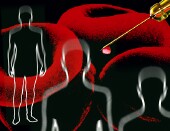
TUESDAY, March 25, 2014 (HealthDay News) — Researchers report that they think they have figured out why patients who take the multiple sclerosis drug Tysabri face a high risk of developing a rare, and sometimes fatal, brain infection.
A common virus that can cause the brain disease progressive multifocal leukoencephalopathy (PML) likes to infect and hide in certain blood cells that are triggered to mobilize by Tysabri, the study authors explained. Even more troubling, the researchers discovered that current tests may be missing some who harbor the virus.
“Right now, the risk of PML in patients treated with [Tysabri] for more than two years is about one in 75 patients. That’s a very high risk,” said study author Eugene Major, a senior investigator at the U.S. National Institute of Neurological Disorders and Stroke (NINDS) in Bethesda, Md.
“We need to be able to understand why this therapy puts patients at risk. As we further define that, we’ll be able to develop better tests and better treatment decisions can be made,” Major said.
In PML, the normally harmless “JC virus” attacks the white matter of the brain, stripping nerve cells of their insulation. Without this insulation, nerve cells can’t effectively carry brain signals. The disease causes progressive weakness, paralysis, changes in vision and speech, and problems with thinking and memory.
According to the NINDS, 30 percent to 50 percent of patients with PML die within a few months of diagnosis. Those who survive the infection may face permanent disability.
Though most people carry the JC virus, PML is rare. It tends to strike people with suppressed immune function, such as patients with AIDS or those taking powerful immune-suppressing drugs like Tysabri.
The drug has had a troubled history. First approved by the U.S. Food and Drug Administration in November 2004, it was pulled off the market three months later after cases of PML occurred in ongoing clinical trials.
Since Tysabri was allowed back on the U.S. market in 2006 with strict prescribing conditions, more than 440 cases of PML have been reported in patients taking the drug, according to the study background. In 2010, the FDA added a warning about the heightened risk of PML to the drug’s labeling.
A combination of three factors seems to put patients at highest risk: treatment with Tysabri for more than two years; receiving other kinds of immune-suppressing medications; and testing positive for antibodies to the JC virus.
To find out why the drug carries such a high risk of PML, researchers collected blood samples from two groups of MS patients — those just starting treatment with Tysabri, and those who had been on the drug for more than two years. They compared those samples to blood taken from healthy volunteers.
The investigators were looking for a particular type of cell in the blood — a kind of stem cell that turns into white blood cells called B-cell lymphocytes.
“Turns out in these MS patients treated with [Tysabri], the number of these blood stem cells is three- to 10-fold higher than you’d see normally under normal physiologic conditions,” Major said.
“JC virus is able to infect these blood stem cells as they become a B lymphocyte,” he explained. His working theory has been that these infected B lymphocytes then carry the infection into the brain.
To test that theory, the researchers wanted to see if they could find traces of the JC virus in circulating blood stem cells.
And they did. Of 26 patients who were just starting treatment with Tysabri, 50 percent had traces of the JC virus in their circulating blood stem cells. Of 23 patients who had taken the drug for more than two years, 44 percent had JC virus DNA in more than one kind of blood stem cell type. In contrast, only 17 percent of the 18 healthy volunteers had signs of the JC virus in those cells.
“It was somewhat surprising to us that quite a high percentage of individuals had detectable viral DNA in these blood stem cells,” Major said.
But what isn’t exactly clear is how this could affect their risk of developing PML. Most patients who tested positive for JC virus had only a few copies of the virus, suggesting that they were still at low risk of infection. Patients who had taken the drug for more than two years had higher virus counts than those who were just starting treatment.
“We need to look at additional patients, and follow them for a long period of time,” Major said.
Perhaps most concerning, 10 study participants had evidence of the JC virus in their blood but tested negative for antibodies to it. That suggests current tests for the virus may be missing some patients who could be at high risk for PML infection, the authors explained.
An expert who was not involved in the study, which was published online March 25 in the journal JAMA Neurology, said the findings left some questions unanswered.
“Clearly, Tysabri seems to engender the release of JC virus-containing cells from the bone marrow,” said Dr. Gary Birnbaum, a neurologist and director of the Multiple Sclerosis Treatment and Research Center in Golden Valley, Minn. “This could explain why risks of PML are high in patients on this drug,” he noted.
“What isn’t clear is why the risk escalates dramatically after two years, since JC virus-bearing cells emerge early in the course of treatment,” Birnbaum pointed out.
Additionally, Birnbaum said it was “disquieting” that researchers found evidence of the JC virus in patients who then tested negative for antibodies to it.
“Thus, testing individuals for exposure to JC virus by measuring antibodies to the virus may be insufficient to fully assess their risks for developing PML,” he said.
More information
Visit the U.S. National Institute of Neurological Disorders and Stroke for more about progressive multifocal leukoencephalopathy.
Copyright © 2025 HealthDay. All rights reserved.

